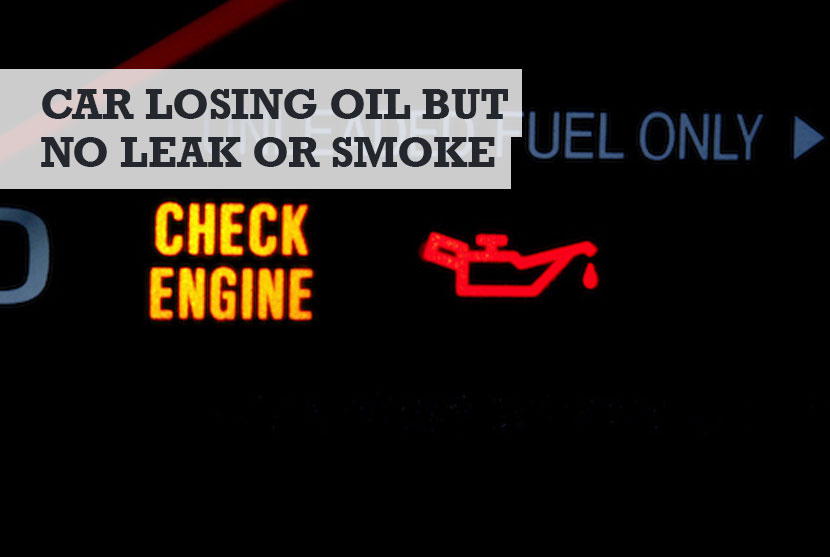If you’re car appears to be losing oil, but you can’t see any signs of a leak underneath, or your not seeing any signs of the oil burning, there’s a number of reasons why. I’ve put the most common reasons for a car losing oil but no leak or smoke below.
I implore you to act though, or get a mechanic involved. A car losing oil without displaying any sign is a red flag. It indicates that something is wrong so needs to be fixed at the earliest to avoid more damage. The earlier it is fixed, the better the chances are of the engine lasting longer.
Coming to the point, just because your car doesn’t emit a whitish-blue smoke, or just because you don’t see signs of an oil leak underneath, it doesn’t mean that your car isn’t burning oil. If your car is losing oil, the fact of the matter is that the oil is burning constantly in small amounts so there’s no smoke being visible.
I’m listing four obvious reasons that cause a drop in a car’s engine oil level and stating the best way to get them fixed. Some fixes are light on the pocket while the others can make a huge hole.
Reasons why your car is burning oil but no smoke or leak
1. Worn out cylinder walls or piston rings:
Piston rings play a major role in the smooth functioning of an engine. They act as a seal against the cylinder walls and help maintain engine compression. The rings ensure that the combustion chamber is sealed properly to prevent gases from entering the oil sump.
If the piston ring or the cylinder is worn out, it causes gaps between the rings and the cylinder wall that allows the engine oil to leak into the combustion chamber. Initially, this may happen slowly so one may not see white or blue smoke being emitted from the exhaust.
But, over time as the rate of oil burn increases, that is when you’ll be able to witness the smoke. But the damage done to the engine at that point in time would be more. This problem occurs due to wear and tear, usually when the engine has been abused or when it has aged enough. In rare cases, a manufacturing defect in the engine could also cause this problem.
The fix for this problem is to open the engine and inspect the worn-out parts first. Then, they must be replaced with new and original parts. This job should be carried out by an expert who is familiar with engine overhauling.
Handy Hint: Can you also smell burnt rubber when driving?
2. Failed head gasket
The head gasket fuses the engine head and the cylinder block together. It also prevents an exchange of liquids like oil and coolant. Over time due to high temperature and pressure, the head gasket starts to give in on the weak spots. Air then starts to frequent the gaps.
The spots get weaker with more vibration and rising temperatures, thereby exposing the oil gallery and allowing the oil to seep into the cylinders and the combustion system. Again, this won’t happen overnight unless the head gasket is blown due to a tremendous rise in pressure.
When oil enters the combustion chamber, it starts to burn. As mentioned earlier, you may not witness smoke being emitted by your car in the early stages but the fact is that your car continues to burn the oil.
The fix for this problem is to first get the head gasket inspected. Then, it must be replaced with a new head gasket. This isn’t a simply DIY job unless you’ve done this before so you will need a good mechanic to do the job for you.
3. Clogged PCV system:
The positive crankcase ventilation (PCV) system eliminates harmful gases by channeling them back to the combustion chamber. The system senses unburnt harmful gases that run the risk of being sent out from the car’s exhaust.
The PCV system sends the gases back into the combustion chamber where they are completely burnt. As a result, the PCV system is a vital piece of kit in any car. However, over time, if the PCV is blocked or clogged, the system could face difficulties in sensing the gases.
It will then begin to erroneously suck engine oil along with the unburnt gases and push them into the combustion chamber. This way, the quantity of oil gradually decreases since it keeps getting burnt.
The ideal solution to this problem is to not unclog the PCV valve since the problem may re-occur but, to get the clogged PCV valve replaced with a new one by a mechanic.
4. Faulty valve stem seal:
If any of your valves have a faulty or worn stem seal, it could cause the oil to leak into the combustion chamber, burning it in the process. The valve stem seam is responsible to regulate oil consumption and to lubricate the valves.
If any of the valve seals are broken, instead of regulating oil consumption, the seal will allow the oil to seep into the combustion chamber. Depending on the intensity of valve seal damage, the oil burn may or may not be visible in the form of smoke from the exhaust.
However, after driving the car for a few hundred miles, you will be able to notice a drop in the oil level. The process to replace a valve seal is complex and you will need an expert to do it for you.
Related questions
Why is there no smoke if my car is burning oil?
Smoke being emitted from the car’s exhaust as a result of burning engine oil depends directly on the amount of oil entering the combustion chamber. If the flow of oil into the chamber is high, then you will notice the smoke. But, if the rate of oil being flowed into the combustion chamber is low, then there are low chances of smoke being visible.
Is it bad to drive a car that burns oil?
In a way, yes. If the cause for the oil burn is a worn-out part, chances are that as you drive, it would wear out more and quickly, thereby increasing the chances of a breakdown. When you notice a drop in oil level, it is best to get the problem diagnosed at the earliest to avoid further complications. If you have an unavoidable situation that demands you to drive, you may top up the engine oil before heading out.
How to stop the engine from burning oil?
Oil burn is mostly a cause of rough use and a not-so-well-maintained car. Certain parts need lubrication or replacement as the car ages. If they aren’t replaced and if the correct service intervals are not adhered to, the parts deteriorate quickly and hence, cause the oil to burn as a result of their failure. So, the best practice to prevent oil burning is to not be reckless with the car and to get it serviced on time.
Conclusion
Certain events and occurrences can put one into quite a dilemma. Like in the case where your car consumes a lot of oil but leaves no trace of it. Look underneath and you see no signs of an oil leak. Rev the engine and you see no white smoke.
After all, where could the oil really go? Especially, if your car displays no significant signs of a drop in performance or, an increase in fuel consumption.






